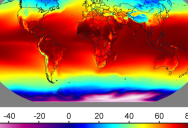How Hot Is Too Hot For Survival? Understanding The “Wet Bulb Temperature” And Why It Matters To Life On Earth

As the average temperatures around the world continue to slowly climb, it has become increasingly important for people to understand when the heat become dangerous.
Of course, there are many factors that contribute to what temperatures are safe for an individual, and for how long.
Those who are elderly or have other health concerns, for example, are much more likely to suffer from heat stroke or other heat related problems that could become fatal.
While looking at the temperature alone is important, one also needs to consider humidity. The higher the humidity, the longer it will take for sweat to evaporate, pulling heat away with it.
This is why it is such a common thing for people to talk about a ‘dry heat’ being more comfortable than similar heat in a humid environment.
Another thing that is becoming increasingly important to look at is being called a ‘Wet Bulb Temperature.’

Measuring the wet bulb temperature is done by wrapping the bulb of a standard thermometer with a wet cloth.
The cloth in this process acts like human skin. When the water evaporates, it takes heat away from the thermometer, cooling it down.
When in an area with high humidity, the water takes much longer to evaporate (or even does not evaporate at all), causing the temperature to remain the same or rise.
To put it simply, the wet bulb temperature is a measurement of how well a human can cope with the heat.
As mentioned above, the specific safe temperature for a given person is going to be different, but in general humans will start to overheat at 35 degrees Celsius (95 degrees Fahrenheit) wet bulb temperatures.
Even when in the shade and having access to water, the body is simply unable to get rid of enough heat to operate properly.

For people who are healthy, they will be able to last longer in these temperatures than those who have other impacting conditions. Given enough time, however, wet bulb temperatures at or above this level will cause serious health issues, or even prove to be fatal.
Colin Raymond, the lead author of a study in 2020 that looked at severe heat and humidity, commented on how often we experience these levels of heat.
“Previous studies projected that this would happen several decades from now, but this shows it’s happening right now. The times these events last will increase, and the areas they affect will grow in direct correlation with global warming.”
This means that as climate change continues, people will experience dangerous wet bulb temperatures more often.
This will undoubtedly mean that more people will experience health problems, or even death, due to the high temperatures.
When they experience high wet bulb temperatures, it is essential for people to move to a cooler area to stay safe.
If you thought that was interesting, you might like to read about why we should be worried about the leak in the bottom of the ocean.

Sign up to get our BEST stories of the week straight to your inbox.




